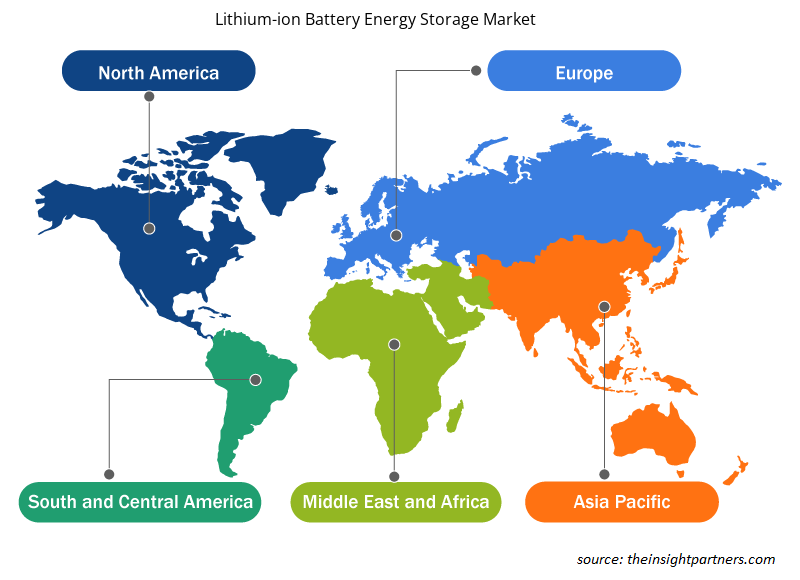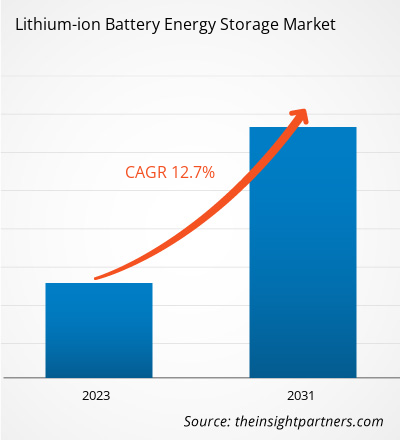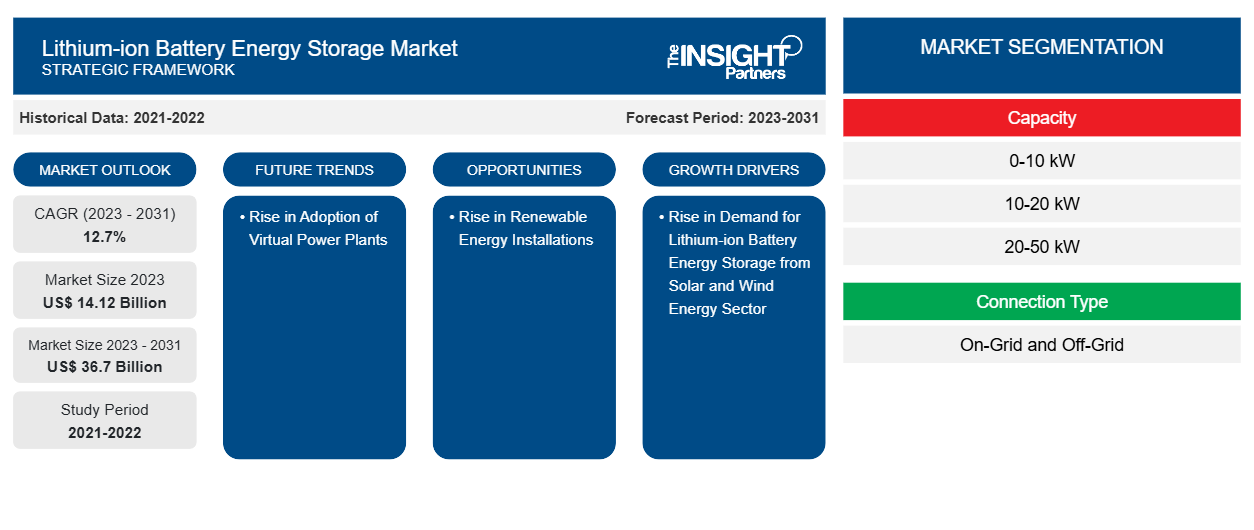Si prevede che la dimensione del mercato dell'accumulo di energia tramite batterie agli ioni di litio raggiungerà i 36,7 miliardi di dollari entro il 2031, rispetto ai 14,12 miliardi di dollari del 2023. Si prevede che il mercato registrerà un CAGR del 12,7% nel periodo 2023-2031. Si prevede che l'aumento della domanda di centrali elettriche virtuali rimarrà una tendenza chiave nel mercato dell'accumulo di energia tramite batterie agli ioni di litio.
Analisi del mercato dell'accumulo di energia tramite batterie agli ioni di litio
Si prevede che la crescente domanda di generazione di energia rinnovabile in tutto il mondo alimenterà la crescita del mercato durante il periodo di previsione. Inoltre, si prevede che la crescente istituzione di impianti solari ed eolici nelle regioni tra cui Asia Pacifico, Europa e Nord America alimenterà la domanda di accumulo di energia tramite batterie agli ioni di litio, che a sua volta dovrebbe guidare la crescita del mercato dal 2023 al 2031. Inoltre, si prevede che la crescita del settore dei veicoli elettrici (EV) in tutto il mondo per ridurre le emissioni di carbonio nel settore dei trasporti alimenterà la domanda di soluzioni di generazione di energia rinnovabile e di accumulo di energia tramite batterie, che si tradurrà nell'alimentazione della crescita del mercato nel periodo di tempo analizzato.
Panoramica del mercato dell'accumulo di energia tramite batterie agli ioni di litio
Gli stakeholder principali nel mercato dell'accumulo di energia delle batterie agli ioni di litio sono i fornitori di materie prime, i produttori di componenti, i produttori di accumulo di energia delle batterie agli ioni di litio e gli utenti finali. Il fornitore di materie prime è uno stakeholder cruciale nell'ecosistema del mercato dell'accumulo di energia delle batterie agli ioni di litio. Solo l'Australia produce il 52% del litio mondiale. In base ai materiali degli elettrodi, ci sono sei diversi tipi di celle al litio: LFP, NMC, LCO, NCA, LTO e LMO. Le materie prime più importanti utilizzate per le batterie agli ioni di litio sono materiali catodici, materiali anodici, elettroliti, separatori e collettori di corrente. In base alla forma della cella, ci sono tre tipi di batterie agli ioni di litio: cilindriche, a sacchetto e prismatiche, ciascuna con parametri di prestazioni della batteria distinti. Le materie prime richieste per i sistemi di accumulo di energia delle batterie agli ioni di litio includono metalli non ferrosi e minerali come litio, cobalto, nichel, manganese, grafite, rame e alluminio. I principali produttori di batterie agli ioni di litio includono A123 Systems LLC, Panasonic Corporation, SAMSUNG SDI Co, Toshiba Corporation e altri.
Personalizza questo report in base alle tue esigenze
Riceverai la personalizzazione gratuita di qualsiasi report, comprese parti di questo report, o analisi a livello nazionale, pacchetto dati Excel, oltre a usufruire di grandi offerte e sconti per start-up e università
-
Scopri le principali tendenze di mercato in questo rapporto.Questo campione GRATUITO includerà analisi di dati che spaziano dalle tendenze di mercato alle stime e alle previsioni.
Driver e opportunità del mercato dell'accumulo di energia tramite batterie agli ioni di litio
Aumento del numero di progetti di energia solare ed eolica per favorire il mercato
Si prevede che l'aumento della creazione di progetti di energia solare ed eolica in tutto il mondo per promuovere la generazione di energia basata sulle energie rinnovabili guiderà la crescita del mercato nei prossimi anni. L'aumento della capacità è il risultato di numerose iniziative e supporti governativi, tra cui aste, tariffe feed-in, misurazione netta e contratti per differenza. Dal 2021 al 2022, i governi di varie economie hanno adottato politiche significative e adeguamenti degli obiettivi che hanno avuto un impatto sulla crescita del solare fotovoltaico. Ad esempio, a luglio 2021, la Commissione europea ha proposto di aumentare l'obiettivo di energia rinnovabile dell'Unione dal 32% al 40% entro il 2030. Il piano REPowerEU ha ulteriormente aumentato l'obiettivo, portandolo al 45% a maggio 2022 (il che richiederebbe 1.236 GW di energia rinnovabile installata, inclusi 600 GW di solare fotovoltaico). L'Inflation Reduction Act, una legge che aumenterebbe il sostegno alle energie rinnovabili nel decennio successivo attraverso crediti d'imposta e altre misure, è stata introdotta dal governo federale degli Stati Uniti nell'agosto 2022. Tali iniziative del governo mirano a stabilire progetti di energia solare ed eolica che dovrebbero guidare la crescita del mercato nei prossimi anni.
Progetti di energia rinnovabile nel futuro
I sistemi di accumulo di batterie (BESS) che incorporano energia rinnovabile offrono enormi vantaggi come autosufficienza energetica, efficienza dei costi, resilienza energetica, vantaggi ambientali e supporto alla rete. Ecco perché molti paesi industrializzati si affidano alle energie rinnovabili. Secondo l'Agenzia Internazionale per l'Energia (IEA), si prevede che la Cina aggiungerà circa la metà della nuova capacità di energia rinnovabile del mondo tra il 2022 e il 2027, poiché si prevede che la crescita dei BESS accelererà nei successivi cinque anni nonostante la rimozione dei sussidi per l'energia solare ed eolica. I BESS possono mantenere un intervallo di tensione stabile iniettando energia reattiva nella rete elettrica. Il sistema è importante per le fonti di energia rinnovabile poiché la loro natura intermittente può causare fluttuazioni di tensione. Può fornire una funzione di avvio in black-start che consente a un sistema di alimentazione di riavviarsi dopo un'interruzione di corrente completa.
Analisi della segmentazione del rapporto di mercato sull'accumulo di energia delle batterie agli ioni di litio
I segmenti chiave che hanno contribuito alla derivazione dell'analisi del mercato dell'accumulo di energia delle batterie agli ioni di litio sono la capacità, il tipo di connessione e l'utente finale
- In base alla capacità, il mercato dell'accumulo di energia tramite batterie agli ioni di litio (LiBES) è suddiviso in 0-10 kW, 10-20 kW, 20-50 kW e oltre 50 kW. Il segmento 10-20 kW ha detenuto una quota di mercato maggiore nel 2023.
- In base al tipo di connessione, il mercato è classificato in on-grid e off-grid. Il segmento on-grid ha detenuto la quota maggiore del mercato nel 2023.
- In termini di utilizzo finale, il mercato è classificato in residenziale, commerciale, industriale e di pubblica utilità. Il segmento di pubblica utilità ha detenuto una quota significativa del mercato nel 2023.
Analisi della quota di mercato dell'accumulo di energia delle batterie agli ioni di litio per area geografica
L'ambito geografico del rapporto sul mercato dell'accumulo di energia tramite batterie agli ioni di litio è suddiviso principalmente in cinque regioni: Nord America, Asia Pacifico, Europa, Medio Oriente e Africa, Sud e Centro America.
L'Asia Pacifica è leader di mercato con una quota di oltre il 43% nell'anno 2023. La Cina è uno dei paesi di spicco nel mercato dell'accumulo di energia con batterie agli ioni di litio nell'Asia Pacifica. Secondo la National Energy Administration (NEA) cinese, la produzione di energia solare ed eolica è aumentata del 21%, raggiungendo 1.190 TWh nel 2022. Ciò ha rappresentato il 13,8% del consumo totale di elettricità della Cina, all'incirca equivalente al consumo di tutte le famiglie urbane e rurali. Inoltre, le politiche governative di supporto amplieranno ulteriormente l'installazione di capacità di energia rinnovabile. Secondo il Consiglio di Stato della Repubblica Popolare Cinese (RPC), la Cina ha aggiunto una capacità totale di 125 GW di parchi solari ed eolici nel 2022, portando la capacità totale a 1.213 GW, di cui il fotovoltaico ha rappresentato 87,4 GW. Si prevede che tali iniziative per sviluppare progetti di energia solare ed eolica stimoleranno il mercato dell'accumulo di energia con batterie agli ioni di litio dal 2023 al 2031.
Approfondimenti regionali sul mercato dell'accumulo di energia delle batterie agli ioni di litio
Le tendenze regionali e i fattori che influenzano il mercato dell'accumulo di energia delle batterie agli ioni di litio durante il periodo di previsione sono stati ampiamente spiegati dagli analisti di Insight Partners. Questa sezione discute anche i segmenti e la geografia del mercato dell'accumulo di energia delle batterie agli ioni di litio in Nord America, Europa, Asia Pacifico, Medio Oriente e Africa e America meridionale e centrale.

- Ottieni i dati specifici regionali per il mercato dell'accumulo di energia delle batterie agli ioni di litio
Ambito del rapporto sul mercato dell'accumulo di energia delle batterie agli ioni di litio
| Attributo del report | Dettagli |
|---|---|
| Dimensioni del mercato nel 2023 | 14,12 miliardi di dollari USA |
| Dimensioni del mercato entro il 2031 | 36,7 miliardi di dollari USA |
| CAGR globale (2023-2031) | 12,7% |
| Dati storici | 2021-2022 |
| Periodo di previsione | 2023-2031 |
| Segmenti coperti |
Per capacità
|
| Regioni e Paesi coperti |
America del Nord
|
| Leader di mercato e profili aziendali chiave |
|
Densità degli attori del mercato: comprendere il suo impatto sulle dinamiche aziendali
Il mercato dell'accumulo di energia delle batterie agli ioni di litio sta crescendo rapidamente, spinto dalla crescente domanda degli utenti finali dovuta a fattori quali l'evoluzione delle preferenze dei consumatori, i progressi tecnologici e una maggiore consapevolezza dei vantaggi del prodotto. Con l'aumento della domanda, le aziende stanno ampliando le loro offerte, innovando per soddisfare le esigenze dei consumatori e capitalizzando sulle tendenze emergenti, il che alimenta ulteriormente la crescita del mercato.
La densità degli operatori di mercato si riferisce alla distribuzione di aziende o società che operano in un particolare mercato o settore. Indica quanti concorrenti (operatori di mercato) sono presenti in un dato spazio di mercato in relazione alle sue dimensioni o al valore di mercato totale.
Le principali aziende che operano nel mercato dell'accumulo di energia tramite batterie agli ioni di litio sono:
- Energia NextEra
- Inc.
- Potenza KORE
- Enel Energia Verde
- Energia della libellula
- Energia Siemens
Disclaimer : le aziende elencate sopra non sono classificate secondo un ordine particolare.

- Ottieni una panoramica dei principali attori del mercato dell'accumulo di energia tramite batterie agli ioni di litio
Notizie e sviluppi recenti sul mercato dell'accumulo di energia delle batterie agli ioni di litio
Il mercato dell'accumulo di energia delle batterie agli ioni di litio viene valutato raccogliendo dati qualitativi e quantitativi dopo la ricerca primaria e secondaria, che include importanti pubblicazioni aziendali, dati di associazioni e database. Di seguito sono elencati alcuni degli sviluppi nel mercato dell'accumulo di energia delle batterie agli ioni di litio:
- Morrow Batteries e ABB hanno firmato due accordi di Memorandum of Understanding per rafforzare la loro partnership e promuovere il passaggio a fonti di energia rinnovabili e all'elettrificazione in tutti i settori della società. In base agli accordi, ABB è stata selezionata come fornitore di tecnologia preferito non esclusivo per la produzione e l'alimentazione di Morrow. L'obiettivo è garantire che la giga factory pianificata presso l'Eyde Energy Park in Norvegia diventi una delle strutture più convenienti e sostenibili a livello globale. Questa partnership mira a sfruttare la competenza e l'esperienza di ABB per ottimizzare il processo di produzione di Morrow e consentire la produzione di batterie sostenibili e di alta qualità. (Fonte: ABB Ltd, comunicato stampa, settembre 2022)
- Exide Industries e il suo partner di joint venture, Leclanche SA, hanno annunciato il lancio del più grande stabilimento di batterie agli ioni di litio dell'India nel Gujarat. L'impianto ha sei linee di assemblaggio automatizzate e una capacità installata di 1,5 GWh. Si concentrerà sulla produzione di batterie per automobili e applicazioni di accumulo di energia. La società di joint venture Nexcharge ha rilasciato una dichiarazione che conferma l'inizio della produzione di massa presso la struttura. (Fonte: Exide Industries Ltd, comunicato stampa, maggio 2022)
Copertura e risultati del rapporto sul mercato dell'accumulo di energia delle batterie agli ioni di litio
Il rapporto "Dimensioni e previsioni del mercato dell'accumulo di energia delle batterie agli ioni di litio (2021-2031)" fornisce un'analisi dettagliata del mercato che copre le seguenti aree:
- Dimensioni e previsioni del mercato dell'accumulo di energia tramite batterie agli ioni di litio a livello globale, regionale e nazionale per tutti i principali segmenti di mercato coperti dall'ambito
- Tendenze del mercato dell'accumulo di energia tramite batterie agli ioni di litio e dinamiche di mercato quali driver, vincoli e opportunità chiave
- Analisi PEST e SWOT dettagliate
- Analisi del mercato dell'accumulo di energia tramite batterie agli ioni di litio che copre le principali tendenze del mercato, il quadro globale e regionale, i principali attori, le normative e i recenti sviluppi del mercato
- Analisi del panorama industriale e della concorrenza che copre la concentrazione del mercato, l'analisi della mappa di calore, i principali attori e gli sviluppi recenti per il mercato dell'accumulo di energia delle batterie agli ioni di litio
- Profili aziendali dettagliati
- Analisi storica (2 anni), anno base, previsione (7 anni) con CAGR
- Analisi PEST e SWOT
- Valore/volume delle dimensioni del mercato - Globale, Regionale, Nazionale
- Industria e panorama competitivo
- Set di dati Excel
Report recenti
Rapporti correlati
Testimonianze
Motivo dell'acquisto
- Processo decisionale informato
- Comprensione delle dinamiche di mercato
- Analisi competitiva
- Analisi dei clienti
- Previsioni di mercato
- Mitigazione del rischio
- Pianificazione strategica
- Giustificazione degli investimenti
- Identificazione dei mercati emergenti
- Miglioramento delle strategie di marketing
- Aumento dell'efficienza operativa
- Allineamento alle tendenze normative























 Ottieni un campione gratuito per - Mercato dell'accumulo di energia tramite batterie agli ioni di litio
Ottieni un campione gratuito per - Mercato dell'accumulo di energia tramite batterie agli ioni di litio